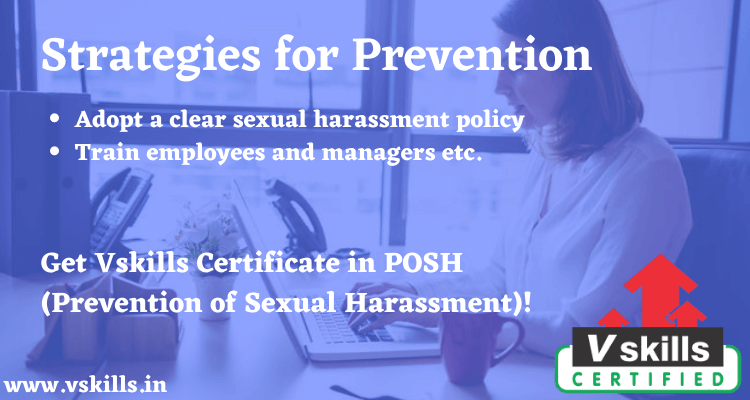
Strategies for Prevention- There are a number of steps that you can take to reduce the risk of sexual harassment occurring in your workplace. Although you may not be able to take all of the steps listed below, you should take as many of them as you can. Let us discuss some Strategies for Prevention.
Adopt a clear sexual harassment policy
In your employee handbook, you should have a policy devoted to sexual harassment. That policy should:
- define sexual harassment
- state in no uncertain terms that you will not tolerate sexual harassment
- state that you will discipline or fire any wrongdoers
- set out a clear procedure for filing sexual harassment complaints
- state that you will investigate fully any complaint that you receive, and
- state that you will not tolerate retaliation against anyone who complains about sexual harassment.
Train employees
This is one of the Strategies for Prevention. At least once a year, conduct training sessions for employees. These sessions should teach employees what sexual harassment is, explain that employees have a right to a workplace free of sexual harassment, review your complaint procedure, and encourage employees to use it.
Train supervisors and managers
Another one of the Strategies for Prevention, at least once a year, conducts training sessions for supervisors and managers that are separate from the employee sessions.
Build it into every manager’s performance expectations
Sexual harassment isn’t just a C-suite problem, even though celebrity cases have to come to dominate the headlines. It can occur anywhere in an organization. So, what can a company do to drill awareness down through all levels? One easy, practical solution: Build zero-tolerance harassment-related language into every manager’s performance objectives.
Have a universally known, 100% safe reporting mechanism
How often does sexual harassment go unreported because women don’t where to go with the information, or are afraid they’ll be somehow ridiculed or punished for it? One institutional solution: A universally known, easily accessible – and absolutely safe – place to report it.
Tone at the top
Taking the lead on preventing sexual harassment needs to come from the very top of an organization. We all know how much influence a CEO has, and he or she needs to make it “clear as a mountain crick” there’s zero tolerance for sexual harassment. If the message comes only from Human Resources.
Layout the clear protocol for responding to harassment
Within your anti-harassment policy, make the steps for reporting sexual harassment clear. Your policy must encourage victims of sexual harassment to report the behavior. Authorize and identify several appropriate to receive harassment complaints. Your employees should have several options of individuals to report sexual harassment to, as this will help prevent them from.
Include examples your employees might not recognize
Employees need to understand that any form of sexual attention or behavior, as well as any form of sexist or transphobic behavior, is considered sex discrimination and could get them fired. Let them know, for instance, that men are liable if they harass men, not just women, that women are liable if they harass men or women, and that even compliments can feel like harassment if they are given the wrong way.
- Explain that any workplace pressure that employees comply with gender norms is sex harassment. Therefore, it is forbidden to tell a woman she does not act feminine enough, a man that he does not act masculine enough, or a transgender individual that his or her appearance or chosen pronoun is unacceptable.
- Explain that as an employer, you are even sometimes liable if a vendor or client sexually harasses your employees.
- Tell them that when in doubt, they should talk to HR or to you.
Enforce the policy without exceptions
When a complaint arises, or when you witness harassment, immediately investigate and deal with the situation. Discipline company members who harass other employees. Protect and support employees experiencing harassment.
- You should have a no-tolerance policy on repeat offenders, or for cases of egregious harassment or assault.
- Make it clear that no level of management is exempt from complying with the policy.
Create a positive workplace environment
- Remove offensive, sexually explicit, or pornographic calendars, literature, posters, and other materials from the workplace.
- Develop a policy prohibiting inappropriate use of computer technology, such as e-mail, screen savers, and the internet.
- It is recommended that medium and large employers undertake regular audits to monitor the incidence of sexual harassment in their workplaces and the use and effectiveness of their complaints procedures.
The Role of Managers
Managers and supervisors are the front lines when it comes to managing employee performance and needs from work. First, and most importantly, you do not want a workplace culture that allows any form of harassment to occur. Out of your commitment to your employees and your company, never tolerate harassment, in any form.
As you think about sexual harassment and other forms of harassment in your workplace, keep these facts in mind.
- The employee harassing another employee can be an individual of the same sex.
- The harasser can be the employee’s supervisor, manager, customer, coworker, supplier, peer, or vendor.
- The victim of sexual harassment is not just the employee who is the target of the harassment.
- In the organization’s sexual harassment policy.
- Sexual harassment can occur even when the complainant cannot demonstrate any adverse impact on his or her employment including transfers, discharge, salary decreases, and so on.
- When an individual experiences sexual harassment.
- The employer has the responsibility to take each complaint of sexual harassment seriously and investigate.
- Following the investigation of the harassment complaint.
- Monitor your workplace.
- Take all complaints seriously.


